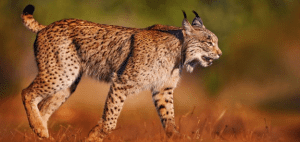TAG: GS 3: ECOLOGY AND ENVIRONMENT
THE CONTEXT: In a remarkable turnaround, the International Union for Conservation of Nature (IUCN) has changed the conservation status of the Iberian Lynx (Lynx pardinus) from ‘Endangered’ to ‘Vulnerable’ as of June 20.
EXPLANATION:
- This change marks one of the most successful conservation efforts in recent history, with the population of this elusive feline now exceeding 2,000 individuals across Spain and Portugal.
Population Growth and Current Status
- The Iberian Lynx population has seen an extraordinary increase from a mere 94 individuals at the start of the 21st century to over 2,000 today.
- In 2001, there were only 62 mature individuals, but by 2022, this number had grown to 648 mature lynxes.
- This impressive recovery highlights the effectiveness of dedicated conservation strategies implemented over nearly 25 years.
Conservation Efforts and Strategies
- The recovery of the Iberian Lynx is attributed to several focused conservation efforts:
- Prey Abundance: Efforts to increase the population of the Endangered European rabbit (Oryctolagus cuniculus), the primary prey of the lynx, have been crucial.
- Habitat Protection and Restoration: Significant work has been done to protect and restore the Mediterranean scrub and forest habitats that the lynx relies on.
- Reduction of Human-Caused Deaths: Measures have been put in place to reduce deaths caused by human activities, such as poaching and road kills.
- Genetic Diversity: The genetic pool of the lynx has been expanded through translocations and an ex-situ breeding program, which have been pivotal in increasing the population.
Reintroduction and Habitat Expansion
- Since 2010, over 400 Iberian Lynxes have been reintroduced to various parts of Portugal and Spain.
- The lynx now occupies at least 3,320 square kilometers, a significant increase from the 449 square kilometers recorded in 2005.
- This expansion underscores the success of reintroduction programs and habitat management.
Ongoing Threats
- Despite the positive trend, several threats continue to jeopardize the Iberian Lynx’s survival:
- European Rabbit Population Fluctuations: The lynx’s primary prey, the European rabbit, faces threats from disease outbreaks, which can severely impact lynx populations.
- Disease Susceptibility: The lynx is vulnerable to diseases transmitted by domestic cats.
- Human Activities: Poaching, road kills, and habitat alterations due to climate change pose ongoing risks.
Collaborative Efforts
- Lynx’s revival is a result of a collaborative effort involving various stakeholders.
- Public bodies, scientific institutions, NGOs, private companies, and local community members, including landowners, farmers, gamekeepers, and hunters, have all played a crucial role.
- The European Union LIFE project provided financial and logistical support essential to the success of these initiatives.
- Looking ahead, there are plans to reintroduce the Iberian Lynx to new sites in central and northern Spain.
- According to scientists, sufficient suitable habitat exists for the species to reach Fully Recovered status within the next 100 years, provided that conservation efforts continue with maximum efficacy.
Iberian Lynx (Lynx pardinus)
- The Iberian lynx (Lynx pardinus) is one of the four extant species within the medium-sized wild cat genus Lynx.
- It is endemic to the Iberian Peninsula in southwestern Europe.
- It is listed as vulnerable on the IUCN Red List.
- In the 20th century, the Iberian lynx population had declined because of overhunting, poaching, fragmentation of suitable habitats, and the population decline of its main prey species, the European rabbit (Oryctolagus cuniculus), caused by myxomatosis and rabbit haemorrhagic disease.
- The Iberian lynx has a short bright yellowish to tawny coloured spotted fur.
- The spots vary in shape and size from small round to elongate.
- They are arranged in lines and decrease in size from the back toward the sides.
- Its head is small with tufted ears and a ruff.
- Its body is short with long legs and a short tail.


